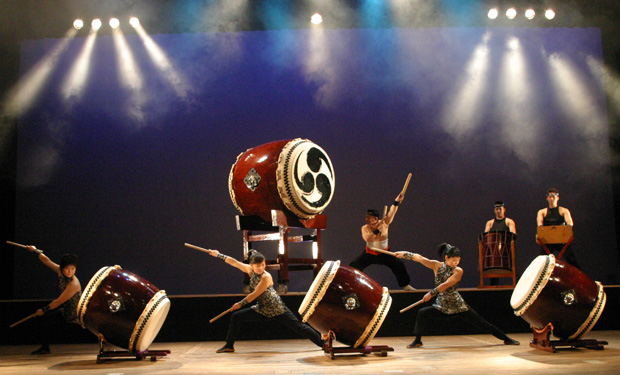- This page
- Home > Profile

Amanojaku’s Vision
Taiko is the soul beat of Japan. For every Japanese, taiko means the village shrine festival, the celebration of a good harvest or fishing catch, the primordial rhythm of folk songs. Amanojaku takes that proud legacy and lands it right on the concert stage of modern art. Amanojaku breathes the funk of Tokyo's cityscape, the multi-layered vibrations of the present and faraway sounds like swing and samba ? all integrated with the Japaneseness of taiko. Amanojaku is also about physical and spiritual discipline. Choreography that accentuates the tune's narrative is a key driving force for the unfolding musical tales.
As one of the world’s most respected taiko ensembles, Amanojaku has toured more than 40 nations, including Thailand (‘06), the United States (’05) and Brazil (’04). Amanojaku has performed at the prestigious Japanese National Theatre four times. Founder and leader Yoichi Watanabe’s compositions often use phrasings inspired by Kabuki-based mood-evoking sound effects that call to mind a cicada’s song, dashing waves, or a voice echoing in a valley, and blends them with other forms of indigenous music. By changing the context, touch and interpretation, Mr. Watanabe takes rhythms such as a Latin bell pattern and makes them sound naturally Japanese. Mr. Watanabe is Special Advisor for Cultural Exchange, appointed by the Japanese government, as well as a First-Class Taiko Instructor certified by the Nippon Taiko Foundation. Mr. Watanabe has taught thousands of students, not only in Japan but also the United States, Brazil and Great Britain.
What is Amanojaku?
In folklore, Amanojaku is a mischievous fairylike imp. Over the years, Amanojaku has come to mean a person who goes against the grain of society. Amanojaku’s music is about looking beyond trends and superficiality in order to find an artistic truth. The concept behind Amanojaku underlines the need of an artist to have the courage to speak the truth. As a Hogaku pioneer, Amanojaku has collaborated with artists playing both Japanese and Western instruments including the three-stringed shamisen, yokobue flute, synthesizer and Latin percussion, for 20 years.




